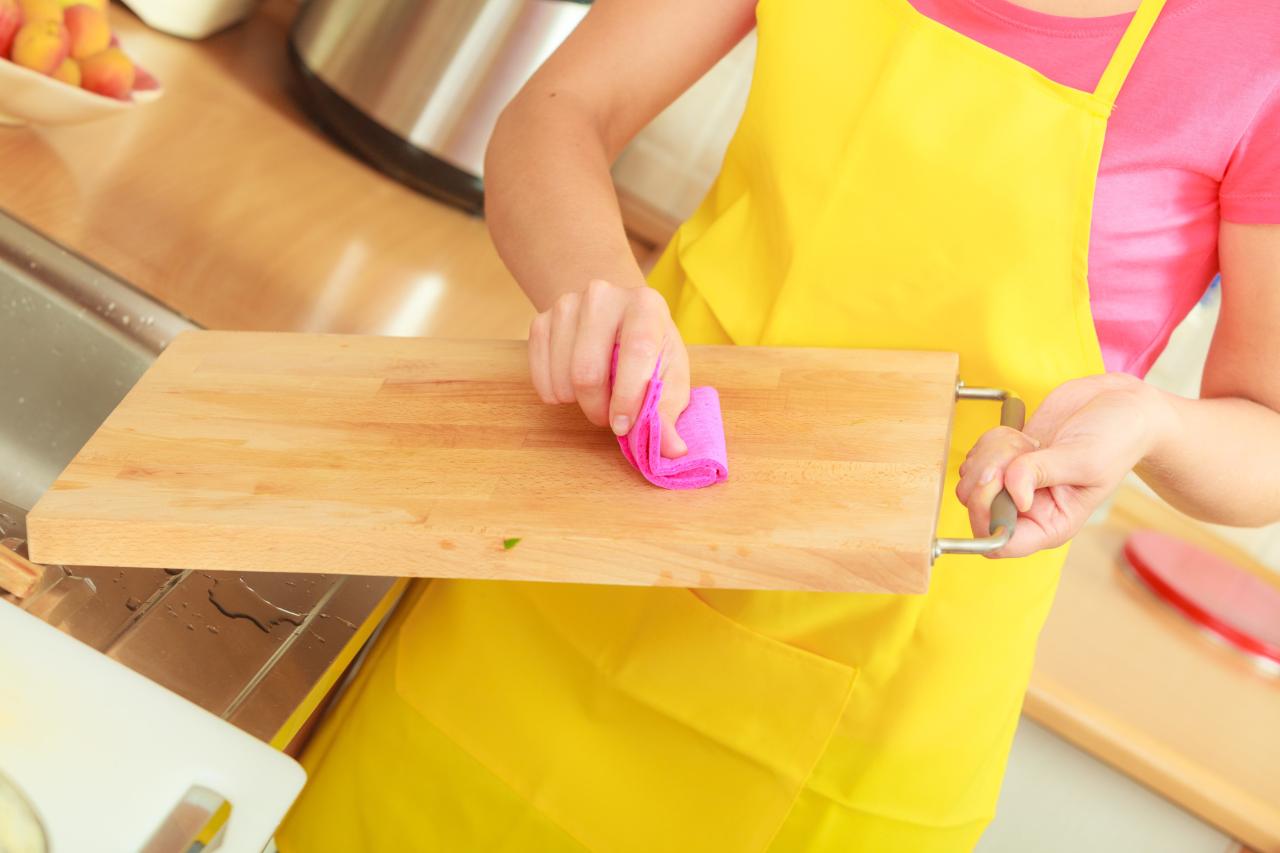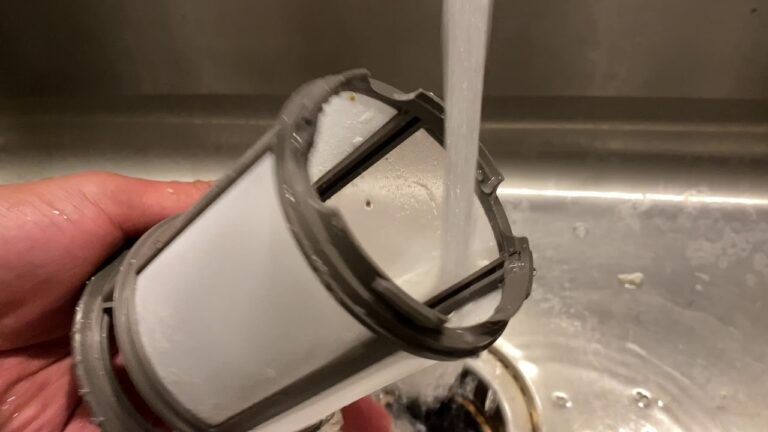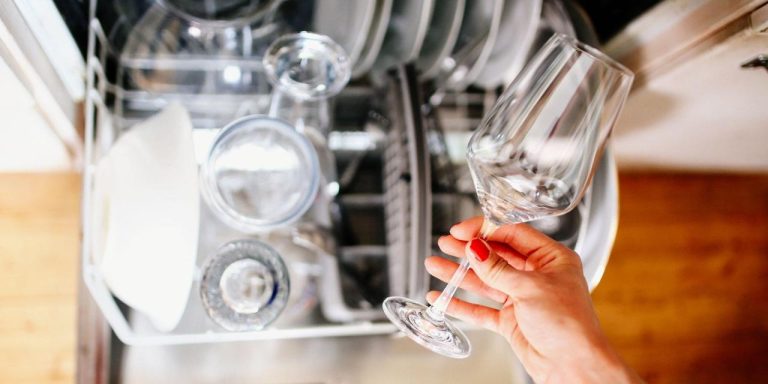Cutting boards are an essential tool in every kitchen, providing a surface for chopping, slicing, and dicing. But how can you ensure that your cutting boards, especially those made of wood, last a lifetime? Here are five hacks, backed by expert advice and real-life examples, that will help you make the most of your cutting boards.

Hack 1: Stop Cutting Boards from Sliding
Understanding the Problem
When cutting boards slide on the countertop, it’s not just an inconvenience; it’s a serious issue that can lead to imprecise cuts and even accidents. The instability of the cutting board can cause the knife to slip, potentially leading to injuries. Moreover, the constant movement of the board can cause wear and tear, especially on wood cutting boards, reducing their lifespan.
Why Traditional Solutions Fail
Many people try to solve this problem by pressing harder on the cutting board or using non-slip mats. However, these solutions can be cumbersome and may not always be effective. Pressing harder can cause unnecessary strain on your hands and wrists, while non-slip mats can be expensive and may not be readily available.
The Simple Yet Effective Solution
The solution to this common problem is surprisingly simple and accessible: Place a damp paper towel under your cutting board to keep it from sliding. This hack uses the natural adhesive quality of the damp paper towel to create friction between the cutting board and the countertop.
Step-by-Step Guide
- Choose the Right Paper Towel: Select a paper towel that is absorbent and strong. A thin or low-quality paper towel may tear easily and won’t provide the necessary grip.
- Dampen the Paper Towel: Wet the paper towel slightly, ensuring that it’s damp but not soaking wet. A paper towel that’s too wet can leave water on the countertop, while one that’s too dry won’t provide enough grip.
- Place the Paper Towel Under the Cutting Board: Lay the damp paper towel on the countertop where you plan to place the cutting board. Then, place the cutting board on top of the paper towel, pressing down slightly to ensure a firm grip.
- Test the Stability: Before you start cutting, give the cutting board a gentle push to make sure it’s stable. If it still slides, you may need to adjust the dampness of the paper towel or use a larger piece.
Why This Hack Works Particularly Well for Wood Cutting Boards
Wood cutting boards are known for their beauty and functionality, but they can be prone to sliding if not properly stabilized. This hack is particularly useful for wood cutting boards as it enhances their longevity and functionality without causing any damage to the wood. The damp paper towel provides just enough grip without being abrasive, preserving the integrity of the wood.
The problem of cutting boards sliding on the countertop is a common yet overlooked issue in many kitchens. By utilizing a simple household item like a damp paper towel, you can create a stable and safe cutting surface. This hack is not only effective but also economical and environmentally friendly, making it a perfect solution for both professional chefs and home cooks. Whether you’re using a wood cutting board or any other type, this hack will ensure that your cutting experience is precise, safe, and enjoyable.
Hack 2: Remove Stains
Understanding Common Stains and Challenges
Cutting boards, especially those made of wood, are prone to stubborn stains that can affect their appearance and hygiene. These stains can come from various sources, such as:
- Food Colors: Ingredients like beets, turmeric, and berries can leave colorful stains.
- Oil and Grease: Fatty foods can leave oily residues that are hard to remove.
- Mineral Deposits: Hard water can leave mineral stains that dull the surface.
- Bacterial Growth: Improper cleaning can lead to bacterial stains and odors.
These stains are not just unsightly; they can also harbor bacteria, affecting the hygiene of the cutting board. Traditional cleaning methods might not be effective, and harsh chemicals can damage the wood.
The Natural Solution: Coarse Salt and Lemon
The solution to removing these stains is both natural and effective. Here’s how you can do it:
- Identify the Stain: Determine the type of stain you’re dealing with. Is it a surface stain or something more ingrained?
- Prepare the Cleaning Agents: You’ll need a generous amount of coarse salt and a lemon cut in half.
- Sprinkle the Salt: Cover the stained area with a liberal amount of coarse salt. The salt acts as a gentle abrasive that helps lift the stain.
- Scrub with Lemon: Take a lemon half and use it as a scrubbing brush. The acidity of the lemon breaks down the stain, while the salt scrubs it away.
- Scrub in Circles: Use circular motions to scrub the stain. Apply gentle pressure to avoid damaging the wood.
- Rinse and Dry: Rinse the cutting board with warm water to remove the salt and lemon residue. Dry it thoroughly to prevent moisture-related issues.
For More Persistent Stains: MacKenzie’s Fisherman Hand Scrub
For stains that resist the salt and lemon treatment, you can use specialized products like MacKenzie’s Fisherman Hand Scrub. This gritty exfoliator is designed to deodorize both hands and cutting boards. Apply it to the stain, scrub gently, rinse, and dry.
Why This Hack Works
- Natural Ingredients: Salt and lemon are natural, non-toxic, and readily available in most kitchens.
- Gentle on Wood: Unlike harsh chemicals, this method won’t damage the wood but will restore its natural beauty.
- Effective Cleaning: The combination of salt’s abrasiveness and lemon’s acidity tackles even the most stubborn stains.
Stains on cutting boards are a common problem that can affect both aesthetics and hygiene. This natural cleaning method using coarse salt and lemon is a simple yet effective way to make your cutting board look as good as new. It’s suitable for all types of cutting boards but is particularly beneficial for wood, preserving its beauty and functionality. Whether dealing with everyday stains or more persistent ones, this hack provides a solution that’s easy, eco-friendly, and efficient.
Hack 3: Remove Odors
Why Odors Matter
Unpleasant odors on a cutting board are more than just a nuisance; they can have a significant impact on the food being prepared. Whether it’s the lingering smell of garlic, fish, or other strong-flavored ingredients, these odors can transfer to other foods, affecting their taste and quality. This is particularly concerning for wood cutting boards, which can absorb odors more easily than plastic or glass ones.
The Challenges of Removing Odors
Removing odors from cutting boards can be tricky. Unlike stains, odors are not always visible, and traditional cleaning methods might not eliminate them. Harsh chemicals can remove odors but may also damage the wood and leave behind their own scent. Therefore, a gentle yet effective solution is needed.
The Innovative Solution: Using a Grated Potato
The solution to this common kitchen problem lies in a humble potato. Here’s how you can use it to remove odors from your cutting board:
- Choose the Right Potato: Select a fresh, firm potato. Any variety will do, but starchy ones like Russet tend to be more effective.
- Grate the Potato: Using a standard kitchen grater, grate the potato over the cutting board, covering the entire surface. The grated potato will act as a sponge, absorbing the odors.
- Let It Sit: Allow the grated potato to sit on the cutting board for at least ten minutes. During this time, the potato will draw out and neutralize the odors.
- Wipe It Away: Using a soft cloth or sponge, gently wipe away the grated potato. Be thorough to ensure that all residues are removed.
- Rinse and Dry: Rinse the cutting board with warm water to remove any remaining potato particles. Dry it thoroughly to prevent moisture-related issues.
Why This Hack is Especially Effective for Wood Cutting Boards
Wood cutting boards are prized for their durability and aesthetic appeal, but they can be prone to absorbing odors. This hack is especially effective for wood because:
- Gentle on Wood: The potato is soft and non-abrasive, so it won’t scratch or damage the wood.
- Preserves Natural Aroma: Unlike chemical cleaners, the potato doesn’t leave behind any scent, preserving the wood’s natural aroma.
- Eco-Friendly: This method uses a natural, biodegradable ingredient, making it an environmentally friendly option.
Unpleasant odors on a cutting board can compromise the flavor and quality of your food. This innovative hack using a grated potato offers a simple, natural, and effective solution to this common problem. It’s particularly beneficial for wood cutting boards, preserving their natural beauty and functionality. Whether you’re a professional chef or a home cook, this method ensures that your cutting board remains odor-free, enhancing your culinary experience.
Hack 4: Oil Dull Cutting Boards
The Importance of Oiling
Oiling a cutting board is not merely a cosmetic enhancement; it’s a vital maintenance task, especially for wood cutting boards. Over time, cutting boards can become scratched, dry, and dull. These imperfections not only affect the appearance but can also create crevices where bacteria can hide. Oiling helps to:
- Fill Scratches: The oil fills in small scratches and imperfections, creating a smooth surface.
- Prevent Drying and Cracking: Regular oiling keeps the wood hydrated, preventing it from drying out and cracking.
- Enhance Appearance: Oiling restores the rich color and luster of the wood, making an old cutting board look brand new.
- Create a Protective Barrier: The oil acts as a barrier against moisture, odors, and stains, prolonging the life of the cutting board.
Choosing the Right Oil
The choice of oil is crucial. It must be food-safe and not prone to rancidity. Food-grade mineral oil is the preferred choice for many professionals. It’s odorless, tasteless, and has a long shelf life. Other options include beeswax and certain plant-based oils like coconut oil.
The Step-by-Step Process to Oil a Cutting Board
- Clean the Cutting Board: Before oiling, ensure that the cutting board is clean and completely dry.
- Apply the Oil: Pour a generous amount of food-grade mineral oil onto the cutting board. Using a soft cloth or paper towel, spread the oil evenly over the entire surface, including the sides, top, bottom, and any groove, grip, or handle.
- Let It Soak: Allow the oil to soak into the wood for at least three hours. The wood will absorb the oil, replenishing its moisture content.
- Wipe Off Excess Oil: After the soaking period, wipe off any excess oil using a clean, dry cloth.
- Dry on Its Edge: Leave the cutting board on its edge to dry. This ensures that both sides dry evenly and prevents any warping.
- Repeat if Necessary: If the cutting board is extremely dry or hasn’t been oiled in a long time, you may need to repeat the process.
Regular Maintenance
Oiling a cutting board is not a one-time task. Regular maintenance, depending on the frequency of use and the condition of the wood, ensures that the cutting board remains in optimal condition. A monthly oiling routine is common, but this can vary based on individual needs.
Oiling a cutting board is an essential maintenance practice that goes beyond mere aesthetics. It ensures that the cutting board remains functional, hygienic, and beautiful. This process, particularly beneficial for wood cutting boards, revitalizes and preserves them, making them a lasting asset in your kitchen. Whether you’re a culinary expert or a cooking enthusiast, this simple yet effective hack will keep your cutting boards in peak condition, enhancing your cooking experience.
Hack 5: Use Your Cutting Board as a Serving Platter
Versatility in the Kitchen: More Than Just a Cutting Surface
A wood cutting board is a staple in most kitchens, known for its durability and aesthetic appeal. But its utility extends beyond just a surface for chopping and slicing. A wood cutting board can also serve as a beautiful serving platter, adding a touch of rustic elegance to your table setting.
Why Consider Using a Cutting Board as a Serving Platter?
- Aesthetic Appeal: Wood cutting boards have a natural, warm appearance that can enhance the visual appeal of the food served on them.
- Economical: By using a cutting board as a serving platter, you save money on buying specialized serving dishes.
- Space-Saving: This multifunctional use helps in maximizing kitchen storage, especially in small kitchens where space is at a premium.
- Sustainability: Using what you already have reduces the need for additional kitchenware, aligning with eco-friendly practices.
How to Transform Your Cutting Board into a Serving Platter
- Choose the Right Cutting Board: Select a cutting board that is in good condition, without deep cuts or stains. The size and shape should suit the food you plan to serve.
- Clean and Prepare: Ensure that the cutting board is thoroughly cleaned and dried. If you regularly oil your cutting board, it should have a nice sheen that adds to its attractiveness.
- Arrange the Food Thoughtfully: Consider the visual layout. For charcuterie or cheese boards, for example, arrange the items in a way that is both aesthetically pleasing and practical for guests to serve themselves.
- Add Garnishes: Fresh herbs, edible flowers, or other garnishes can add color and enhance the presentation.
- Consider Pairing with Other Natural Elements: If you’re going for a rustic theme, consider pairing the wood cutting board with other natural elements like burlap, twine, or stone.
- Provide Appropriate Serving Utensils: Depending on what you’re serving, include the necessary utensils for guests to serve themselves easily.
Tips for Success
- Avoid Cross-Contamination: If you use the cutting board for raw meats or allergenic foods, consider dedicating a specific board for serving to avoid cross-contamination.
- Protect the Surface: If serving something particularly messy or staining, you might want to add a protective layer, such as parchment paper.
- Embrace the Imperfections: Small cuts or wear marks can add character to the presentation, embracing a rustic or farmhouse style.
The idea of using a wood cutting board as a serving platter is a creative and practical way to make the most of what you have in your kitchen. It not only adds a rustic touch to your presentation but also aligns with economical and sustainable practices. Whether hosting a formal dinner or a casual gathering, this simple yet elegant hack can elevate your serving style, showcasing your culinary creations in a way that’s both beautiful and functional.
Additional Tips for Care and Maintenance
Keep It Dry
Understanding the Importance of Dryness
Dampness is a silent enemy of wood cutting boards. It can lead to a host of problems, including warping, cracking, and mildew growth. Here’s how to ensure that your cutting board stays dry:
- Wash Properly: After washing, rinse the cutting board thoroughly to remove any soap residue.
- Hand Dry: Use a clean towel to wipe the cutting board dry immediately after washing.
- Air Dry: Stand the cutting board on its edge and allow it to air dry completely.
- Avoid the Dishwasher: Never put a wood cutting board in the dishwasher. The intense heat and prolonged exposure to water can deform the wood.
Hydrate It
The Need for Regular Oiling
Wood is a natural material that requires hydration to maintain its integrity. Regularly oiling the wood with food-safe mineral oil is essential to prevent it from becoming dry and brittle.
- Choose the Right Oil: Food-grade mineral oil, beeswax, or specific cutting board creams are ideal.
- Frequency: The frequency of oiling depends on usage and the climate. In dry environments, more frequent oiling may be required.
- Application: Apply the oil with a soft cloth, ensuring all surfaces are covered. Allow it to soak in, then wipe off the excess.
Rehab It
Restoring a Neglected Cutting Board
Over time, cutting boards may show signs of wear, such as gouges, cut marks, or mildew spots. Here’s how to rehabilitate them:
- Choose the Right Sandpaper: A very fine sandpaper, such as 220 grit, is ideal for this purpose.
- Sand Evenly: Sand the surface evenly, following the grain of the wood.
- Clean and Oil: After sanding, clean the cutting board and apply a fresh coat of oil to restore its luster.
Let It Go
Knowing When to Replace a Cutting Board
A cutting board’s lifespan depends on many factors, including the type of wood, usage, and maintenance. However, if the board has a crack, it’s time to replace it. Cracks can become an open invitation for bacteria and mold, compromising food safety.
- Inspect Regularly: Regular inspection for cracks or deep cuts is essential.
- Consider Repurposing: If you decide to replace the cutting board, consider repurposing it for non-food-related uses.
Proper care and maintenance of a cutting board, especially one made of wood, are vital for its longevity and functionality. These additional tips provide a comprehensive guide to keeping your cutting board in optimal condition. From keeping it dry to knowing when to let it go, these practices ensure that your cutting board remains a valuable asset in your kitchen, enhancing both the cooking process and the overall culinary experience. Whether you’re a seasoned chef or a cooking enthusiast, these insights will help you make the most of your cutting board, preserving its beauty and utility for years to come.
Conclusion
Cutting boards, especially those made of wood, are valuable kitchen tools that can last a lifetime if properly cared for. By following these five hacks and additional care tips, you can ensure that your cutting boards remain functional, beautiful, and long-lasting. Remember, a little TLC goes a long way in making your cutting boards an enduring part of your kitchen.





